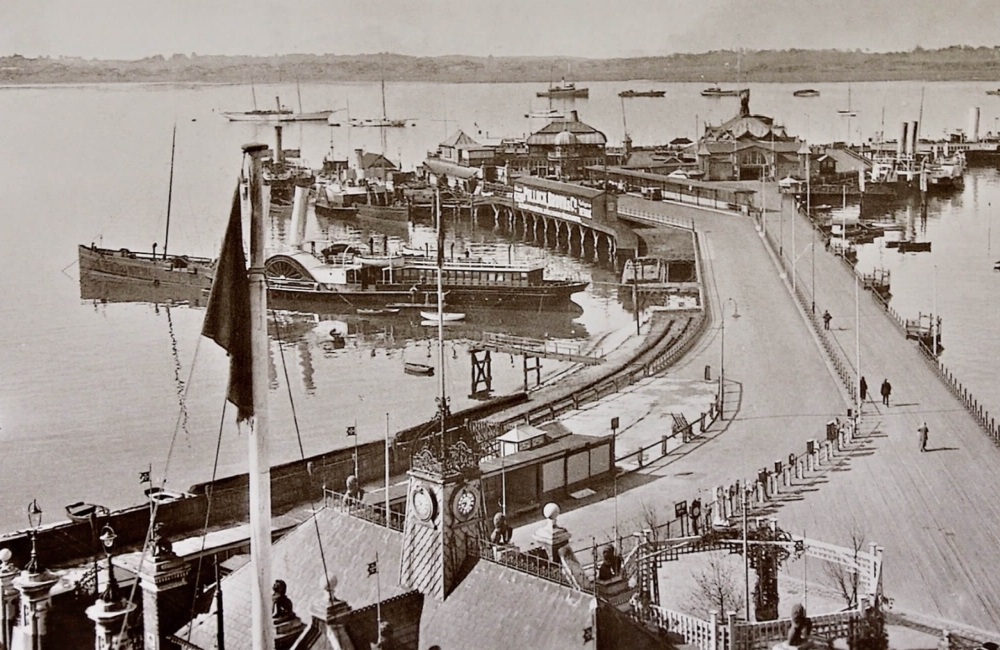The design of the Solent steamer was fine tuned and perfected over the years. Early examples were rarely more than 100 ft long, built of wood, they had attractive 'clipper' style bows. Later ships had iron hulls, a conventional bow, were twice as long and considerably wider.
There were notable differences between ships used exclusively for excursions (Lorna Doone I, Balmoral I and Bournemouth Queen) and the multi-purpose steamers on the Packet Services were used for tendering duties and occasional excursions. These latter ships all had deck space for vehicles, luggage and lift-on lift-off cargo. The last paddle steamer built in 1936 had a raised forecastle deck to give shelter to cars from spray in a choppy Solent sea and was fitted with a bow rudder to aid manoeuverability.
Paddle Steamer Engines
Paddle steamers typically used oil-fired boilers, which provided heat to boil the water, and subsequent steam is then piped to the cylinders. The movement of the steam entering and exiting the cylinders exerts pressure on the pistons, creating motion. The steam is then piped to the condenser where it is converted back to water. The water is then recycled back to the boiler. The back and forth movement of each piston translates into a rotary motion of a crank shaft. The crank shaft turns the paddle shaft (rod) which ultimately turns the paddle wheel.
The first steamers had just a single engine developing 32hp or less, but as the ships got bigger and speed became important, more power was required. By the late 1850's power had increased to 50 hp from two oscillating engines. Morgan's patent feathering paddles also started to appear on new builds. By the 1870's compound diagonal or compound oscillating engines were in use with an output of 90hp or more. Troublesome or defective boilers often spelt the end of ageing steamers when it was not economical to fit new ones.
Paddle Steamer Accommodation
By 1927 paddlers had an open foredeck, a main deck saloon aft for first class passengers with alleyways alongside, a forecabin on the lower deck for officers accommodation and a bar for second class travellers. A dining room was also located aft on the lower deck. A later innovation was hot water pipe heating and electric light in the saloons and even an imitation log fire!
The top of the deck saloon was fitted out as a promenade deck for passengers, and on some ships it was extended to the sides so offering some weather protection to second class passengers using the open alleyway seats.
Paddle Steamer Catering and Entertainment
There is no question that the quality of food and first class service on board contributed significantly to Red Funnel's success. Food was served by the smartest of Silver Service waiters, using the finest china and cutlery in the most elegant dining rooms and "unsurpassed for moderation in price". Advertising slogans of the day spelt out the message from the beaks of following seagulls "We always follow Red Funnel Steamers, the food is so good".
A band playing the latest dance and orchestral music often accompanied many of the excursion trips, and deck chairs were available for passengers at 2d. for each single journey.
Related Links
Balmoral: White Funnel Limited operate Balmoral, a former Red Funnel ship and one of the last surviving ships of its type. A member of the National Historic Fleet, Balmoral launched back into active service in June 2015 offering a wide range of coastal day excursion cruises.
Waverley Excursions: The Trust operate the paddle steamer Waverley, the last sea going paddler in the world.
Kingswear Castle: The paddle steamer Kingswear Castle is the last remaining coal-fired paddle steamer in operation in the UK today.
Paddle Steamer Preservation Society: The Paddle Steamer Preservation Society is Britain's longest established, largest and most successful steamship preservation group. Founded in 1959, they have sailed ships since 1975.
Paddle Steamers Worldwide: The Internet's leading source of Paddle Steamer information.
The Steam Boat Association of Great Britain (SBA): Formed in 1971 to promote the enjoyment of steamboats and to represent the interests of steamboat owners.


